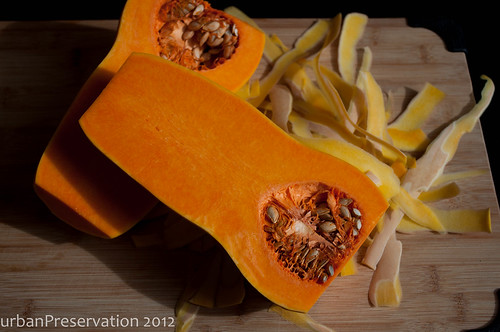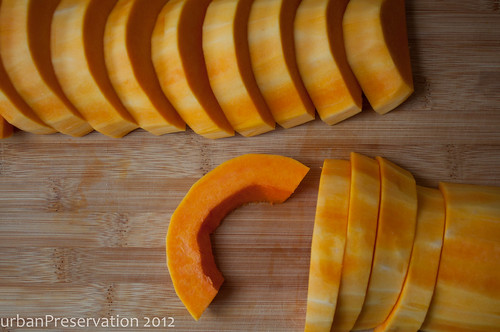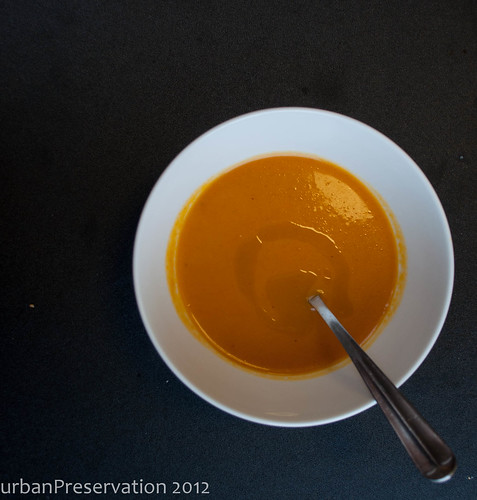
I love ordering this second kind of soup in restaurants – it’s so rich and smooth, obviously full of butter and requiring annoying amounts of time. At home I stuck to the soups with lots of pieces of vegetable, meat, and grains, until recently when I discovered a surprising trick to homemade soup. In The French Laundry Cookbook, of which I own a well loved (read: stained) copy, there’s a small ode to soups and how they’re made. For a man known for extremely complex dishes with many, many steps, Thomas Keller’s approach to soup is fascinatingly simple: “Identify your ingredient, cook it perfectly, and adjust the consistency.” Perhaps the “perfectly” is not so simple to achieve but the idea of good soup coming from careful preparation of one or two ingredients caught my eye and I started experimenting with this principle.

The recipe below is for butternut squash soup but it can easily be adapted for just about any vegetable whose flavor improves with roasting (cauliflower, parsnips, broccoli, carrots). The overall method remains pretty much the same – cook the vegetable to the desired taste, puree it, and thin it with water or stock. While the French Laundry method requires straining the resulting puree several times through progressively smaller straining devices, I’m not looking for perfection in my kitchen, just comfort and deliciousness. If I’m feeling industrious I might pass the vegetables through a food mill or my fancy chinois. But normally I just blend them for a few minutes on high using my immersion blender and call it a day. You can add cream for the additional flavor and body but it mutes the flavor of the vegetables, as will butter. I like to keep things simple by adding just a drizzle of oil to my bowl at the table.

For added flavor during cooking my favorite low-cost flavor addition to homemade soup is Parmesan rinds. I save the ends of all my Parmesan wedges after I’ve grated them to the bone and then throw one or two into soups. It adds an extra flavor without the unpleasant graininess that can happen when you put cheese in soup and let it simmer for a while. However, the soup can easily be made vegan by omitting the rinds and still tastes excellent on its own. As a low maintenance recipe with high quality output this soup is something I can really get behind when the weather turns gray. A hot bowl served with some thick bread or a crisp salad is really all it takes at the end of gray day to make things look sunnier. Maybe some slippers too.

Butternut squash soup
Method adapted from the French Laundry Cookbook
Makes 3-4 servings, depending on your preferred texture.
1 large butternut squash, about 3-4 pounds
2-3 tbs olive oil
1 tbs kosher salt
2-4 cups stock or water, more if needed
2 parmesan rinds
Salt and pepper to taste
Good quality oil for serving
Preheat oven to 425F. Peel and chop squash into approximately 1 inch chunks. Line a baking sheet with foil and oil it lightly with about 1 tbs of olive oil to prevent sticking. Arrange squash on the pan, making sure each piece is resting on the sheet, not on it’s neighbor. Drizzle with remaining oil and sprinkle with 1 tbs salt. Roast for 1hour, tossing the squash halfway through to ensure that it cooks evenly and doesn’t burn on the side touching the pan.
While the squash is still warm, puree using a food processor, food mill, blender, or immersion blender. For a smoother texture, pass the resulting puree through a fine-mesh strainer or chinois. Place the vegetable puree in a large pot and add liquid until it reaches desired consistency. Place the pot on low heat, add parmesan rinds, and simmer for at least 30 minutes. If left longer, cover the soup to prevent excess loss of moisture. Taste after 30 minutes and season with salt and pepper until it reaches the desired flavor. Discard rinds before serving. Serve with a drizzle of good quality oil and some chewy bread or a salad for an easy rainy day meal.
No comments:
Post a Comment